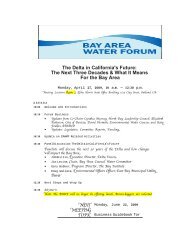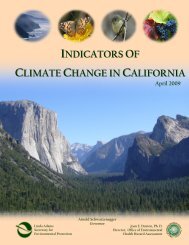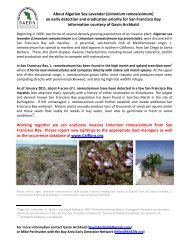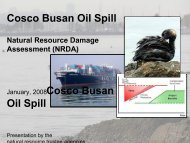Bird Species and Climate Change: The Global Status Report - WWF
Bird Species and Climate Change: The Global Status Report - WWF
Bird Species and Climate Change: The Global Status Report - WWF
Create successful ePaper yourself
Turn your PDF publications into a flip-book with our unique Google optimized e-Paper software.
Predicting the individual responsesof different species to a wide array ofhabitat changes on migration routesspanning the globe is difficult <strong>and</strong> ishindered by uncertainty in models <strong>and</strong>a lack of detailed studies (Barlein <strong>and</strong>Hüppop, 2004). According to Saether(2000), “One frightening consequenceof these findings is that they illustratehow difficult it will be to reliably predictthe effects of large-scale regionalclimate change on ecological systems.”6.3.2 Wetl<strong>and</strong> birds“Given the potentially seriousconsequences of globalwarming for waterfowlpopulations ... society hasyet another reason to act toslow greenhouse warming<strong>and</strong> safeguard the future ofthese resources.”Sorenson et al., 1998Under 3-4°C of warming, 85 per centof all remaining wetl<strong>and</strong>s could beeliminated (UNEP, 2005) -- a radicalalteration of wetl<strong>and</strong> birds’ currenthabitat. Some European coastal areas,for example, are forecast to loose up to100 per cent of their wetl<strong>and</strong> stock by2080 (IPCC, 2001b). As a result of thesechanges, 40 per cent of migratory birdspecies face impacts from predictedlowering of water tables, 53 per centfrom changes in water regimes overall.As noted above, these changes inwater regimes are actually the mostwidespread climatic threats to migratorybird species (DEFRA, 2005).Remaining wetl<strong>and</strong>s will face anincreasingly variable hydrological cycle,which would leave inl<strong>and</strong> wetl<strong>and</strong>sto dry out, resulting in lower speciesdiversity (see case study 3). Coastalmarshes will also be affected, dueto rising sea-level <strong>and</strong> changes inhydrological balance <strong>and</strong> severity. Asnoted in Section 2, habitat in estuaries<strong>and</strong> deltas will be lost if barriers preventa natural retreat as sea levels rise(coastal squeeze; UNEP, 2005; IPCC2001b). One of the most severe threatsto birds, this is a particular problem inEurope where l<strong>and</strong>ward extension ofsalt marshes is restricted by hard seadefences, for example by dams <strong>and</strong>dykes in the Wadden Sea (Böhning-Gaese <strong>and</strong> Lemoine, 2004; Bairlein <strong>and</strong>Hüppop, 2004).In the Arctic, permafrost melting willcause lakes <strong>and</strong> wetl<strong>and</strong>s to drainin some areas, while creating newwetl<strong>and</strong>s in others. <strong>The</strong> balance of theseeffects is unknown, but major speciesshifts are likely as a result (ACIA, 2004).<strong>Bird</strong> <strong>Species</strong> <strong>and</strong> <strong>Climate</strong> <strong>Change</strong>: <strong>The</strong> <strong>Global</strong> <strong>Status</strong> <strong>Report</strong>58<strong>Climate</strong> Risk






